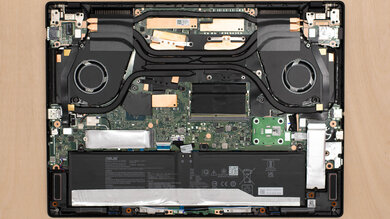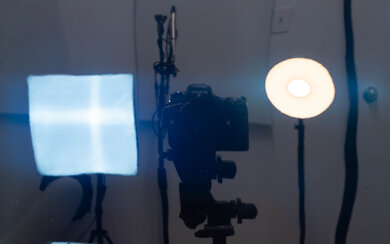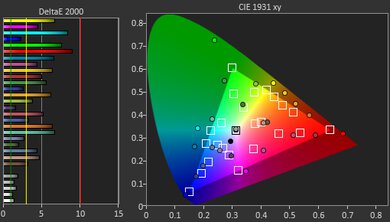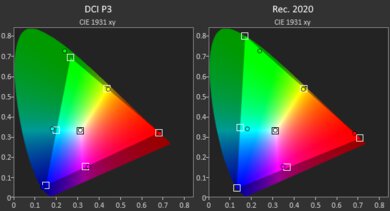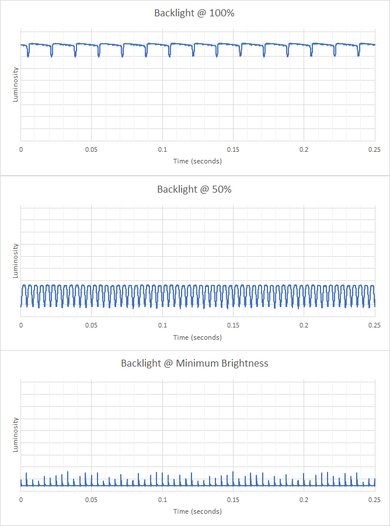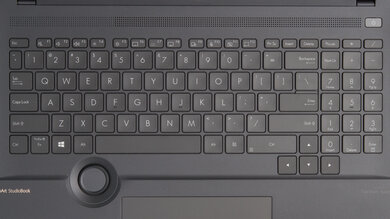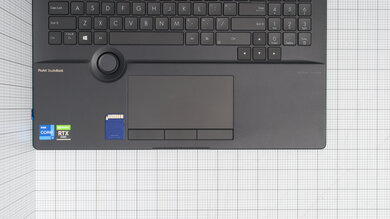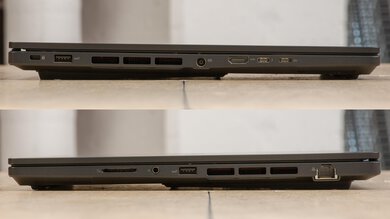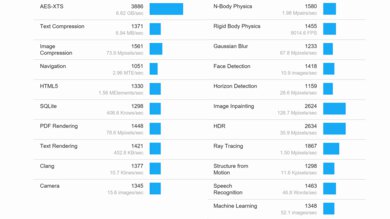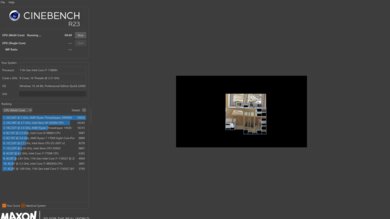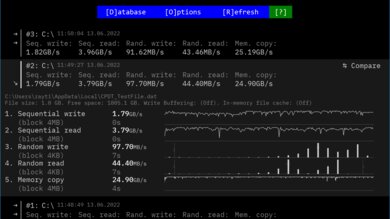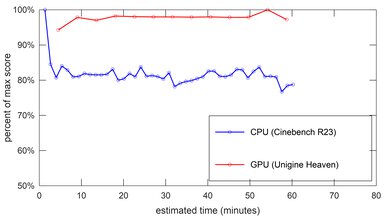The ASUS ProArt Studiobook Pro 16 OLED (2021) is a premium mobile workstation. It's a new line of ASUS laptops designed for creators, featuring a unique dial that you can use to access various settings and a 16:10 4k OLED display with full sRGB and DCI P3 coverage. The W7600 (reviewed model) is available with Intel 11th Gen CPUs paired with an NVIDIA RTX A3000 or A5000 discrete GPU. There are other models in the ASUS ProArt Studiobook lineup, including the H5600 model with AMD Ryzen 5000 series CPUs and NVIDIA GeForce GPUs, the W5600 model with AMD Ryzen 5000 series CPUs and an NVIDIA RTX A2000 GPU, and the H7600 model with Intel 11th Gen CPUs and NVIDIA GeForce GPUs. At the time of writing, there's already a newer 2022 model with Intel 12th Gen CPUs.
Our ASUS ProArt Studiobook 16 OLED has an Intel Core i7-1800H CPU, an NVIDIA RTX A3000 discrete GPU, 64GB of memory, and 2TB of storage in a RAID 0 array. There's only one other CPU option, the Intel Xeon W-11955M, and it's the only option if you want ECC (Error Correction Code) memory, which improves system stability. If you need better graphical performance, you can upgrade the GPU to an NVIDIA RTX A5000. You can get up to 64GB of non-ECC or ECC memory and up to 4TB of storage in a RAID 0 array.
Our Verdict
The ASUS ProArt Studiobook 16 OLED is decent for school use. It has more than enough CPU and GPU processing power to handle all of your schoolwork, even for students in fields like graphic design or engineering. It also provides a great user experience with a large and sharp display, a comfortable keyboard, and a responsive touchpad. However, it isn't very portable as it's slightly bulky and heavy, and its battery lasts only about 5 hours of light use.
- Screen provides plenty of space for multitasking.
- Comfortable keyboard and responsive touchpad.
- Feels exceptionally well-built.
- Slightly bulky and heavy.
- Short battery life.
- Risk of permanent burn-in on OLED display.
The ASUS ProArt Studiobook 16 OLED is good for gaming. Its Intel 11th Gen CPUs and NVIDIA GPUs provide a smooth gaming experience at 1080p or 1440p. You can even play some games at 4k if you get the RTX A5000 GPU. However, it has a 60Hz display with no VRR support to reduce screen tearing. It doesn't get hot or loud under load, and while there's some throttling on the CPU, there's none on the GPU. The memory and storage are user-upgradeable, and there are plenty of ports for your peripherals and external displays, including an HDMI 2.1 port.
- Relatively fast response time.
- Provides smooth gameplay in modern titles at 1080p or 1440p.
- Doesn't get overly hot or loud under load.
- User-replaceable memory and storage drive.
- 60Hz refresh rate and no VRR.
- CPU throttles under load.
The ASUS ProArt Studiobook 16 OLED is good for media consumption. It has an OLED display that produces vibrant colors and deep, inky blacks. It gets bright enough to combat glare and also gets very dim to make it more comfortable to view in dark settings. The speakers sound loud and clear with good instrument separation, though they don't have much bass. Unfortunately, it isn't very portable, as it's bulky and heavy, and its battery lasts less than 3 hours of video playback.
- Sharp OLED display with full DCI P3 coverage.
- Loud and clear-sounding speakers.
- Good color accuracy out of the box.
- Slightly bulky and heavy.
- Short battery life.
- Screen flicker may cause eye strain.
- Risk of permanent burn-in on OLED display.
The ASUS ProArt Studiobook 16 OLED is excellent for use as a workstation. Its Intel 11th CPUs and NVIDIA discrete GPUs are powerful enough to handle demanding workloads, like video editing and 3D graphics. It has a 4k OLED display with full sRGB and DCI P3 coverage, a comfortable keyboard, and a wide port selection that includes a Thunderbolt 4 and an HDMI 2.1 port. It also features a unique dial that you can use to access various settings and functions, like changing the brush size in Photoshop or navigating the timeline in Premiere Pro. There's some thermal throttling on the CPU under load, but none on the GPU. Its serviceability is good as you can replace the memory, storage, and battery.
- Sharp OLED display with full DCI P3 coverage.
- Unique dial allows for easy access to various settings and functions.
- Wide port selection includes HDMI 2.1 and USB-C/Thunderbolt 4.
- Doesn't get overly hot or loud under load.
- User-replaceable memory and storage drive.
- CPU throttles under load.
- Risk of permanent burn-in on OLED display.
The ASUS ProArt Studiobook 16 OLED is very good for business use. Its Intel CPU and NVIDIA GPU have more than enough processing power to handle all of your tasks, like web browsing, text formatting, spreadsheets, and presentations. It has a bright 4k display that provides plenty of room for multitasking, a comfortable keyboard that you can type on all day, and a smooth and responsive touchpad. It feels very well-built, but it isn't very portable as it's bulky and heavy. You'll also have to carry the charger with you as the battery lasts only around 5 hours of light use.
- Screen provides plenty of space for multitasking.
- Comfortable keyboard and responsive touchpad.
- Feels exceptionally well-built.
- Wide port selection includes HDMI 2.1 and USB-C/Thunderbolt 4.
- Slightly bulky and heavy.
- Short battery life.
- Risk of permanent burn-in on OLED display.
Changelog
-
Updated Apr 25, 2025:
Added mention of the ASUS ProArt P16 H7606 (2024) as an alternative with better performance in the Geekbench 5 section.
- Updated Aug 08, 2022: Added mention of the Lenovo ThinkPad P15 Gen 2 (2021) as an alternative with longer battery life.
- Updated Jul 12, 2022: Review published.
- Updated Jul 04, 2022: Early access published.
Differences Between Sizes And Variants
We tested the ASUS ProArt Studiobook Pro 16 OLED (W7600) with an Intel Core i7-11800H CPU, an NVIDIA RTX A3000 discrete GPU, 64GB of memory, and 2TB of storage in a RAID 0 array. The CPU, GPU, memory, and storage are configurable; you can see the available options in the table below.
| Screen |
|
|---|---|
| CPU |
|
| GPU |
|
| Memory |
Non-ECC memory:
ECC memory:
|
| Storage |
|
| Color |
|
Our display and performance results are only valid for the configuration we tested. If you come across a different configuration option not listed above, or you have a similar ASUS ProArt Studiobook 16 OLED that doesn't correspond to our review, let us know, and we'll update it. Some tests, like black uniformity and color accuracy, may vary between individual units.
You can see our unit's label here.
Popular Laptop Comparisons
Compared to other mobile workstations, the ASUS ProArt Studiobook 16 OLED is unique and stands out for its features, like its customizable dial, OLED display, and touchpad with pen input support.
For other options, see our recommendations for the best laptops, the best business laptops, and the best 2-in-1 laptops.
The ASUS ProArt Studiobook Pro 16 OLED (2021) and the Apple MacBook Pro 16 (M1, 2021) are both premium 16-inch mobile workstations designed for demanding production workloads like video editing and graphic design. Choosing between them depends on which applications you use and whether you can make use of each laptop's unique features. For example, Final Cut Pro is only available on macOS, while Adobe applications tend to work better on Windows systems with an Intel CPU and an NVIDIA GPU. The ASUS has better overall graphical performance, especially if you get the RTX A5000 GPU; however, the Apple MacBook Pro has dedicated media engines that significantly improve performance in supported applications. If you want a laptop you can also game on, the ASUS is a better choice as games will run more smoothly on Windows.
The ASUS ProArt Studiobook Pro 16 OLED (2021) and the Apple MacBook Pro 14 (M1, 2021) are both premium mobile workstations that can handle demanding production workloads like video editing and CADs. The choice comes down to the size, your personal operating system preference, and the applications you use, as some apps will run better or are only available on a specific platform. The ASUS is more user-upgradeable and a better choice for gaming, as there's a wider selection of games on Windows than on macOS with Apple silicon.
The Dell Precision 3571 (2022) and the ASUS ProArt Studiobook Pro 16 OLED (2021) are very different. The ASUS is a significantly more expensive and premium device. It has better build quality, a better OLED display with wider Adobe RGB and DCI P3 coverage, a more comfortable keyboard, and a larger and more responsive touchpad. It also has more ports and doesn't get as hot or loud under load. The Dell's Intel 12th Gen CPUs perform better than the ASUS' Intel 11th Gen, but the ASUS has more powerful GPU configurations.
The ASUS ProArt Studiobook Pro 16 OLED (2021) and the Dell Precision 5560 (2021) are both premium Windows mobile workstations with Intel 11th Gen CPUs and NVIDIA discrete graphics. Choosing between them depends on whether you prefer as much performance as possible or a more compact and portable device. If you want performance, go with the ASUS because it has more powerful GPU options; otherwise, the Dell is a better option for portability. The ASUS' OLED display has better picture quality, but keep in mind that there's a risk of permanent burn-in, and it also flickers, which might cause eye strain for people sensitive to screen flickering.
Test Results

The ASUS ProArt Studiobook 16 OLED has a fairly understated design except for what ASUS calls the ASUS Dial, a customizable wheel that you can use to access various settings, like volume and screen brightness, as well as other application-specific functions. The speakers are on the bottom of the laptop near the front, as the grills above the keyboard are air vents. There are also air vents on the sides, the back, and the bottom. The three LED indicator lights built into the cutout below the touchpad show the laptop's power status, battery status, and drive activity. There's only one color scheme: Star Black.
The ASUS ProArt Studiobook 16 OLED's build quality is outstanding. It has a sturdy anodized aluminum chassis with a smooth finish that's fairly resistant to scratches and fingerprints. There's only a tiny amount of flex in the display and none in the keyboard deck. It doesn't feel as premium as the Apple MacBook Pro 16 (2021), but it's pretty close. The feet feel solid and adhere firmly to the bottom of the laptop.
The ASUS ProArt Studiobook 16 OLED has an outstanding hinge. It feels smooth when opening and closing the lid, and it doesn't wobble at all. There's a lot of resistance, but you can still open the lid with one hand as the base is heavy enough to keep the laptop from lifting or moving around, which is a nice quality-of-life feature.
The ASUS ProArt Studiobook 16 OLED isn't overly bulky and fits into most bags, but it's heavy. The 240W power adapter is pretty big, and it's also heavy.
The ASUS ProArt Studiobook 16 OLED's serviceability is good. To access the internals, you have to remove 10 T5 Torx screws of three different sizes and undo the clips holding the bottom panel with a pick or prying tool. All replaceable parts are easily accessible. You can find the user and service manuals here. Opening the laptop and changing the hardware may void the manufacturer's warranty.
The ASUS ProArt Studiobook 16 OLED's display is very sharp and provides plenty of room for split-screen multitasking. It has a 16:10 aspect ratio that gives you slightly more vertical space than a standard 16:9 display. It's great for productivity because you can see more information and don't have to scroll as much, but it also means that you'll have black bars at the top and bottom when viewing regular 16:9 videos. Like most OLEDs, there's a risk of permanent burn-in, especially with elements like Windows' taskbar. However, there are features in the MyAsus application to help avoid it, like Pixel Shift and Pixel Refresh.
The ASUS ProArt Studiobook 16 OLED's display gets decently bright. It's just bright enough for use outdoors in broad daylight, though you might still have trouble seeing dark-colored content. The advertised maximum brightness is 550 cd/m², but that's only achievable in HDR. As for dark room viewing, the screen gets very dim to provide a comfortable viewing experience and help reduce eye strain.
As for brightness consistency, there isn't any ABL (Automatic Brightness Limiter), so the screen doesn't dim over time. There's no frame dimming in SDR, meaning the brightness remains the same regardless of the content, but there's some in HDR, as you can see in the various windows below.
- 2% Window: 519 cd/m²
- 10% Window: 553 cd/m²
- 25% Window: 540 cd/m²
- 50% Window: 532 cd/m²
- 100% Window: 401 cd/m²
The ASUS ProArt Studiobook 16 OLED has decent reflection handling. The glossy finish mainly struggles with direct reflections, like a lamp or open window during the day. These reflections make it hard to view dark-color content and are visible when viewing light-color content, even with the screen at maximum brightness.
The ASUS ProArt Studiobook 16 OLED has decent horizontal viewing angles. Colors shift fairly quickly as you move to the side. It isn't an issue when sharing a text document or casual content with someone else, but it isn't ideal for any color-critical work. It's best to be directly in front of the screen if accuracy is important.
The ASUS ProArt Studiobook 16 OLED has decent vertical viewing angles. Similar to the horizontal viewing angles, the main issue is color shifting, which happens when viewing the screen from above or below. Again, the image quality is still good enough for sharing casual content or text documents, but you have to look at the screen more or less straight on to get the best accuracy.
The ASUS ProArt Studiobook 16 OLED has good color accuracy out of the box. The white balance is excellent, but most colors are inaccurate and oversaturated because it targets a wide color gamut in its default color profile. The color temperature is just slightly warmer than the standard 6500K, giving the image a barely noticeable reddish tint. The gamma doesn't quite follow the sRGB curve, making bright scenes a little too bright and crushing blacks in dark scenes. Color accuracy varies between individual units, but the difference is usually minimal.
The ASUS ProArt Studiobook 16 OLED has an exceptional color gamut. It has full sRGB and DCI P3 coverage, the color spaces used in most SDR and HDR content, respectively, making it suitable for content creation. It also has near-full coverage of the Adobe RGB color space, which means you can use this panel to edit photos and other printed works.
The ASUS ProArt Studiobook 16 OLED isn't flicker-free. There's a slight drop in brightness at every frame change when the screen brightness is over 50%. At 50% brightness or lower, the screen flickers at 240Hz. It means that people sensitive to flickering may experience eye strain.
The ASUS ProArt Studiobook 16 OLED has an excellent keyboard. It feels spacious and has a fairly standard layout that doesn't take long to adapt to. The keys have a lot of travel, don't require much force to actuate, and provide satisfying tactile feedback. The only thing that could be better is key stability, but even then, it isn't that bad. The keyboard offers an excellent typing experience and doesn't cause fatigue. As for the ASUS Dial, it isn't in the way when typing. You can toggle between three backlight brightness levels or turn it off completely using the F7 hotkey. Lastly, typing noise is very low and shouldn't be bothersome in a quiet environment.
The ASUS ProArt Studiobook 16 OLED has an outstanding touchpad. It's decently large and very responsive, with a maximum polling rate of 155Hz. It tracks all movements and gestures well, and there aren't any issues with palm rejection or actions like dragging and dropping. The touchpad itself doesn't click; instead, you get three dedicated buttons at the bottom. You can customize the middle button via software. The buttons feel a little mushy but still relatively satisfying.
The ASUS ProArt Studiobook 16 OLED has excellent speakers. They get very loud and sound clear, with good instrument separation and a hint of bass. They aren't the most natural-sounding speakers; however, they don't sound overly digital or processed either. DTS Audio processing is on by default, with the profile set to 'Music'. Subjectively, the speakers sound the best in this mode, as turning DTS off makes them sound quieter and less lively. This laptop has an ESS Sabre DAC for high-resolution audio, supporting formats up to 32 bit/384KHz, but it's only in use when you plug in headphones, not when playing through the speakers. Unfortunately, we don't know which ESS Sabre DAC it uses.
The ASUS ProArt Studiobook 16 OLED's webcam video quality is great. The image has a lot of fine details, good exposure, and relatively accurate colors, with only a small amount of noise. The microphone also picks up some background noise, but voices still come through loud and clear. In addition to a physical privacy cover, there are hotkeys to disable the camera and microphone at the software level.
The ASUS ProArt Studiobook 16 OLED has an outstanding port selection. The two USB-A ports support USB 3.2 Gen 2 data transfer speed (up to 10Gbps). The two USB-Cs also support USB 3.2 Gen 2, but only one of them supports Thunderbolt 4 (up to 40Gbps data transfer speed and video output to two external 4k displays at 60Hz). You can charge the laptop via USB-C, but the battery will continue to drain if you perform demanding tasks as the USB-C ports can only accept up to 100W of power. There's a slot for a security lock on the left side.
The ASUS ProArt Studiobook 16 OLED has an Intel Wi-Fi AX201 wireless adapter.
The ASUS ProArt Studiobook 16 OLED is available with the following CPUs:
- Intel Core i7-11800H (8 cores/16 threads, up to 4.6GHz, 24MB cache)
- Intel Xeon W-11955M (8 cores/16 threads, up to 5.0GHz, 24MB cache)
The Intel Core i7-11800H is a mainstream CPU often used in gaming laptops and mobile workstations, while the Intel Xeon W-11955M is almost exclusively in mobile workstations. They're essentially the same CPU, with the main difference being that the Xeon supports ECC memory. The Xeon W-11955M also runs at a higher clock speed than the Core i7-1800H, resulting in slightly better performance. Both CPUs can handle demanding tasks like photo and video editing, 3D graphics, and gaming.
You can configure the ASUS ProArt Studiobook 16 OLED with the following discrete GPUs:
- NVIDIA RTX A3000 with 6GB of GDDR6 VRAM (90W TGP, 105W with Dynamic Boost)
- NVIDIA RTX A5000 with 16GB of GDDR6 VRAM (90W TGP, 110W with Dynamic Boost)
The NVIDIA RTX A3000 and A5000 are both discrete GPUs designed for production workloads like video editing and 3D graphics. You can use them for gaming, though the gaming performance will likely be worse than a laptop with a gaming-focused GeForce GPU equivalent due to drivers. In terms of relative processing power compared to the more popular GeForce RTX GPUs, the A3000 is roughly equivalent to an NVIDIA GeForce RTX 3060 (laptop), while the A5000 is roughly equivalent to an RTX 3080 (laptop). The A3000 has a TGP (Total Graphics Power) of 105W with Dynamic Boost, and the A5000 operates at 110W with Dynamic Boost. This means both GPUs run at the lower end of their respective power range. Taking into consideration each GPU's power configuration, the RTX A5000 is likely around 20% faster than the RTX A3000 in most workloads. There's support for NVIDIA Optimus, meaning the system switches to the CPU's integrated graphics in lighter workloads to prolong battery life.
You can configure the ASUS ProArt Studiobook 16 OLED with 16, 32, or 64GB of memory. You can choose between non-ECC and ECC memory; however, you can only get ECC memory on models with an Intel Xeon W-11955M CPU. ECC (Error Correction Code) RAM is a type of memory that checks and corrects data corruption to provide better system stability. There's a 32GB single-channel option, but it's best to avoid it unless you plan on putting in a second module yourself, as running the laptop in single-channel mode will negatively impact performance.
You can configure the ASUS ProArt Studiobook 16 OLED with 1, 2, or 4TB of storage, and you can choose to get a PCIe Gen 3 x4 or a PCIe Gen 4 x4 drive. The 2TB and 4TB options are available in a RAID 0 array. RAID 0 increases performance by spreading data across the two drives, but you risk losing all data if one drive fails.
The ASUS ProArt Studiobook 16 OLED has an exceptionally high overall score in Geekbench 5. Its single- and multi-thread performance isn't as good as Apple's M1 Max SoC but still among the best for x86 CPUs. It means the Intel Core i7-11800H is powerful enough to handle nearly every type of workload, including demanding tasks like video editing and 3D animation. As for GPU compute tasks, the NVIDIA RTX A3000 performs remarkably well and is suitable for professional production workloads. Changing the fan setting to 'Full Speed' only increases the GPU performance slightly, not the CPU's. Check out the ASUS ProArt P16 H7606 (2024) if you want a similar laptop with better performance.
The ASUS ProArt Studiobook 16 OLED performs exceptionally well in the Cinebench R23 benchmark, making it suitable for professional rendering work. Its multi-thread score is particularly high, nearly on par with Apple's M1 Max SoC, though falling slightly behind Intel's own 12th Gen.
The ASUS ProArt Studiobook 16 OLED's performance in Blender is excellent. While the CPU can complete the render reasonably quickly, using the discrete GPU is much faster, especially with NVIDIA Optix API hardware acceleration. The RTX A5000 will render the same scene only a few seconds faster.
The ASUS ProArt Studiobook 16 OLED has an outstanding score in the Basemark GPU benchmark. It's roughly in the same ballpark as an NVIDIA GeForce RTX 3060, meaning the RTX A3000 can easily handle all games at 1080p and even some at 1440p. The RTX A5000 is faster and will allow you to play games at 1440p and lighter games at 4k.
The ASUS ProArt Studiobook 16 OLED's storage performance is outstanding. It has remarkably fast read and write speeds, making the system as a whole feel more responsive and snappy, like when booting up the computer, opening apps, and transferring files. The sequential read speed is particularly fast as there are two SSDs in a RAID 0 array. The SSD's speed may vary depending on the size, as larger SSDs tend to perform better.
The ASUS ProArt Studiobook 16 OLED's battery life is sub-par. It doesn't last long enough for a typical 8-hour workday, even when performing light tasks like web browsing and text formatting, and it's even shorter for video playback. For demanding workloads like video editing or gaming, you'll have to use the laptop plugged in most of the time. Models with an NVIDIA RTX A5000 GPU will have slightly shorter battery life. If you want a similar mobile workstation laptop with longer battery life, check out the Lenovo ThinkPad P15 Gen 2 (2021). Battery life varies greatly depending on your usage.
The ASUS ProArt Studiobook 16 OLED performs decently in Borderlands 3 at 1080p. The frame rate is high but drops below 30fps at times, causing noticeable stutters. Lowering the graphics settings improves the average frame rate, but you'll still experience occasional stutters. The RTX A5000 will provide smoother gameplay with higher frame rates and fewer frame drops.
The ASUS ProArt Studiobook 16 OLED has no problems running Civilization VI at 1080p with high settings. The gameplay is very smooth, with no stutters at all. You can play it at 1440p and even 4k with just a few tweaks in the settings.
CS:GO runs exceptionally well on the ASUS ProArt Studiobook 16 OLED, good enough for even competitive gamers. The game is CPU-bound at 1080p. You can run it at 1440p or even 4k without lowering any graphical settings, and the same goes for the RTX A5000 GPU.
Shadow of the Tomb Raider runs smoothly on the ASUS ProArt Studiobook 16 OLED at 1080p with high settings. Motion is fluid, with almost no stutter at all. You can even play at 1440p with only a few tweaks in the settings. The RTX A5000 can easily run the game at 1440p, even with high settings. The large frame time spikes are scene changes and aren't representative of the laptop's performance.
The ASUS ProArt Studiobook 16 OLED has good thermal and noise handling. When idle in the 'Standard' power mode, the fans are silent, and the keyboard is only mildly warm. Under load, the fans are audible but aren't annoying or distracting, and while the keyboard does get warmer, it still isn't uncomfortable. If you don't mind louder fans, you can change the power mode to 'Performance' or 'Full Speed'. 'Full Speed' increases fan noise to 60dBA.
The ASUS ProArt Studiobook 16 OLED has decent performance over time. Neither the CPU nor the GPU gets particularly hot under load. However, there's still significant throttling on the CPU, beginning almost as soon as there's a heavy load. The GPU, on the other hand, maintains near-full performance indefinitely.
The ASUS ProArt Studiobook 16 OLED has many pre-installed software applications, including:
- Disney+: App for the video streaming service.
- DTS Audio Processing: Lets you access DTS audio processing settings and audio EQ.
- McAfee LiveSafe: Antivirus and internet security software. Requires subscription.
- McAfee Personal Security: Online privacy protection. This app can also create and store passwords as well as provide identity restoration services. Requires subscription.
- MyAsus: Lets you access system information and user manual, register your laptop for warranty, change power settings, contact customer support, and connect your smartphone for file transfers.
- ProArt Creator Hub: Lets you customize the ASUS Dial.
- Spotify: App for the music streaming service.
This laptop is ISV-certified (Independent Software Vendors), meaning that professional production software companies, like Adobe and Autodesk, have certified that their applications will run reliably on this laptop; you can see the list of certified applications here.
The ASUS ProArt Studiobook 16 OLED has a fingerprint sensor built into the power button and a Windows Hello-compatible IR camera for facial recognition. You can use them to log in quickly, authorize purchases on the Windows Store, or auto-fill saved passwords on supported websites. It also has a wheel next to the touchpad called the ASUS Dial, which you can use to control various settings. While on the desktop, the dial lets you change the speaker volume and screen brightness. The functions you can perform with the dial change depending on the app you use. For example, you can use the dial to change the brush or brush size in Photoshop, zoom in and out of images, or navigate the timeline in Premiere Pro. You can customize the dial via the ProArt Creator Hub application. Lastly, you can use an ASUS Pen on the touchpad, like a digitizer tablet, but you have to purchase the pen separately.





